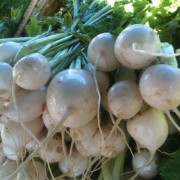Hakurei Turnip
This mini creamy white little globes look more like daikon or radish then turnip. You can find them in bunches in farmers markets with their long green tops on.
They are crisp, tender and juicy all at the same time. They are also unexpectedly sweet for something that looks like a miniature (often golfball size) daikon and is officially a turnip.
You may come across larger versions of hakurei, white and with the same flat round shape but large as baseballs, in the farmers markets called kabu. Kabu is simply the Japanese word for turnip and the larger kabu, though much more tender and sweet then its European cousin, is not considered a salad turnip like hakurei.
All turnips are great sources of vitamin C, potassium, and calcium. Their greens are good sources of vitamins A, C, and B vitamins, potassium, magnesium, and calcium.
Prepping and Eating Tips
– Always wash your Hakurei well before eating. They are so tender that there is no need to peel, so scrub well.
– Trim off the greens, they can be prepared or stored for later preperation.
– You can eat them as is. Chef Dan Barber is known to serve them with just a sprinkling of sea salt. Or you can slice them thin into salads.
– They are also very nice braised, stir-fried, or roasted. Their sweetness increases with cooking. But be aware that when cooked they lose their crispness and tend to turn waterlogged.
– Cook the greens as you would any green.
– Both greens and roots are nice pickled.
Selecting and Storing Tips
Look for turnips free of bruising or soft spots. It’s also good to get Hakurei with greens still attached, these are fresher and still “alive.” Greens should be bright in color.
Cut off greens and store green and roots in separate bags in the refrigerator. With greens off, roots will keep nicely for a week. Greens 3-4 days.
Morsel of History
Hakurei turnips were developed in Japan the 1950s in response to the severe food shortages caused by World War 2. A short growing time, nutritional power and deliciousness – you couldn’t ask for a more valuable food during a time of hardship.
